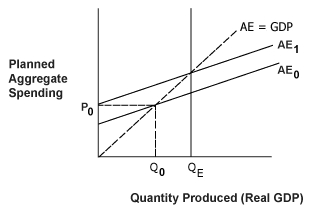Published On:Thursday, 29 December 2011
Posted by Muhammad Atif Saeed
Economic Theories
Classical vs. Keynesian Economics
Under classical economic theory, an economy will always move towards equilibrium at full capacity and full employment. Aggregate demand will adjust to full potential GDP, assisted by flexible wages and prices. Desired savings are kept equal to desired investment by responses to interest rate changes.
British economist John Maynard Keynes took the viewpoint that spending induces businesses to supply goods and services. If consumers become pessimistic about their futures and cut down on their spending, then business will reduce their production. He rejected the classical viewpoint that unemployment would be resolved by flexible wage rates; instead, wages are viewed as being "sticky" when downward pressures exist. Business will produce only the quantities of goods and services that government, consumers, investors and foreigners are expected to buy. If the planned expenditures are less than what would be associated with production at full employment, then output will be less than the economy's full potential.
The Four Components of the Keynesian ModelThere are four components of planned aggregate expenditures in the Keynesian model: consumption, investment, government spending and net exports. Some basic assumptions about the Keynesian model should be noted. When the economy is operating at full employment capacity, then only the natural rate of unemployment is extant. Wages and prices are not flexible until full employment occurs; at that point, increases in demand will only cause prices to go higher.
British economist John Maynard Keynes took the viewpoint that spending induces businesses to supply goods and services. If consumers become pessimistic about their futures and cut down on their spending, then business will reduce their production. He rejected the classical viewpoint that unemployment would be resolved by flexible wage rates; instead, wages are viewed as being "sticky" when downward pressures exist. Business will produce only the quantities of goods and services that government, consumers, investors and foreigners are expected to buy. If the planned expenditures are less than what would be associated with production at full employment, then output will be less than the economy's full potential.
The Four Components of the Keynesian ModelThere are four components of planned aggregate expenditures in the Keynesian model: consumption, investment, government spending and net exports. Some basic assumptions about the Keynesian model should be noted. When the economy is operating at full employment capacity, then only the natural rate of unemployment is extant. Wages and prices are not flexible until full employment occurs; at that point, increases in demand will only cause prices to go higher.
- Consumption - Keynes believed that consumption expenditures are mainly influenced by the level of income. As income increases, consumption will increase but not by as much as the increase in income. The relation between consumption and income is known as the consumption function.
- Investment - This category includes spending on fixed assets such as machinery, and changes in inventories of raw materials and final goods. Keynes believed that in the short run, investment spending is not a function of income.
- Government - As with investment, planned government expenditures are not a function of income.
- Net Exports - Exports remain constant and imports increase as aggregate income rises, so net exports (exports minus imports) will tend to go down as aggregate income goes up.
Formula 4.3
Aggregate Demand = C + I + G + (X - M)
In the Keynesian model, equilibrium is achieved when the value of current production equals planned aggregate expenditures. At that point, there is no incentive for firms to alter their production plans. If expenditures exceed the value of output, business inventories will be drawn down. Firms will need to expand production in order to replenish inventories and meet the higher level of demand. If demand exceeds production, business inventories will rise and production will be cut back until inventories are at normal levels.
Note that equilibrium can occur at levels of output which are below the level of output consistent with full employment.
Figure 4.3: Aggregate Expenditures
 |
In the graph above, AE0 represents aggregate expenditures that would occur at different price levels. The 45 degree line, AE=GDP, represents the points where equilibrium occurs. Equilibrium occurs at point (P0,Q0), where output is less than can be achieved at QF, the output associated with full employment.
Ideally, planned aggregate expenditures will shift to a line such as AE1. At that point, full employment is achieved.
From a Keynesian view, market economies are viewed as being inherently unstable: they are prone to booms and busts. Changes in demand, magnified by multiplier effects, tend to cause wild swings in the economy. Fluctuations in private business investment are the largest cause of the economy swinging to different levels of output.
Monetarists believe that fluctuations in the money supply are the chief source of fluctuations in real economic output and that the major cause of inflation is excessive growth in the money supply.
According to the monetarist view, economies will usually operate at full employment. Aggregate demand is mainly influenced by changes in the money supply. Fluctuations in aggregate demand will be diminished if growth in the money supply is kept at a steady rate.Monetarists concur with the Keynesian viewpoint that wages are "sticky" when downward pressures exist









